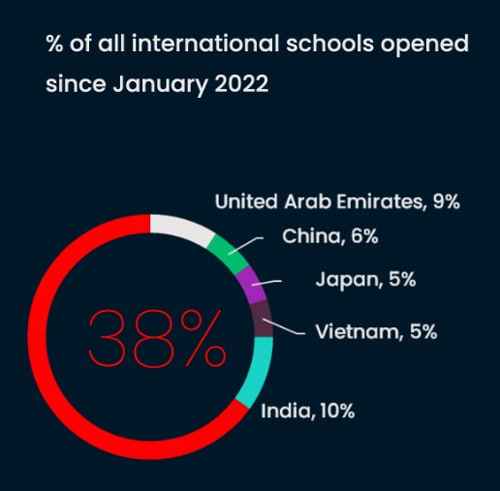International school openings, enrolments, and revenues continue to expand
- Continuing a years-long trend, the number of international schools operating across world regions increased again last year
- The region where the most growth is occurring is Southeast Asia
- On a country level, significant expansion is underway in India, UAE, China, Vietnam, and Japan
Data in a new white paper, “What data tells us about the international schools market?”, published by ISC Research, shows that the international schools sector is thriving in many world regions. Over the past 5 years, the number of schools operating has increased by 8.5% to 14,010, the number of students enrolled has climbed by 10% to 6.9 million, and tuition fee revenue has jumped by over US$9 billion to reach US$60.9 billion in 2024.
While overall, enrolments have grown by 10%, growth has been especially at premium-fee international schools and “mid-market” schools (14% and 17% increases in student numbers, respectively).
More than half of international schools are in Asia (57%), and China and India hold the most schools with 1,106 and 923, respectively. UAE (784), Pakistan (598), and Brazil (415) round out the top 5. The Americas hold 15% of the global share of schools, Europe follows with 14%, and Africa is next with 12%. Only 2% of international schools are in Oceania.
Of all the regions, Southeast Asia is home to the most expansion, not least because many new schools are opening in Vietnam. ISC researchers believe that the countries with the most potential for growth are India, Japan, Vietnam, and UAE, but they remind readers that China remains a growth market. They note:
“This is despite a patriotic education law, which came into effect earlier this year, that added increased scrutiny to any foreign-based schools and teaching methodologies. Whilst it is unclear what the full impact laws such as these will have on school growth within the region, it is not unreasonable to assume an increase in teacher turnover as educators turn their backs on heavy state regulation in the classroom.”
A significant number of Chinese families are also moving to other Asian countries such as Thailand, Japan, and South Korea, say the ISC report authors, and seeking out British independent schools in those countries.
The following chart shows that India has seen the highest level of new schools opened since January 2022 (10%), followed by UAE (9%), China (6%), Vietnam and Japan (5% each).

The new popularity of “hybrid” curricula
A fascinating detail in the report was that while the UK curriculum remains the most common curricula followed by international schools, the number of students following a solely UK curriculum dropped by 6.2% between 2018 and 2023. This is in tandem with demand for “hybrid” curricula rather than single-country curricula (e.g., local curricula woven in or curricula from other countries). ISC data shows that “around two-thirds of schools that opened between 2018 and 2023 doing so with hybrid curricula.” The report authors say that in some cases, local governments are mandating that students take some facets of the local curriculum. Another driver of the trend is families wanting to keep their children’s options open by studying more than one curriculum.
Overall, 77% of international schools worldwide offer one or more of 5 curriculums. The Cambridge curriculum (CAM) holds the most share, followed by the UK curriculum and the International Baccalaureate (IB), then the US curriculum, and then the Advanced Placement (AP).
For additional background, please see:
















